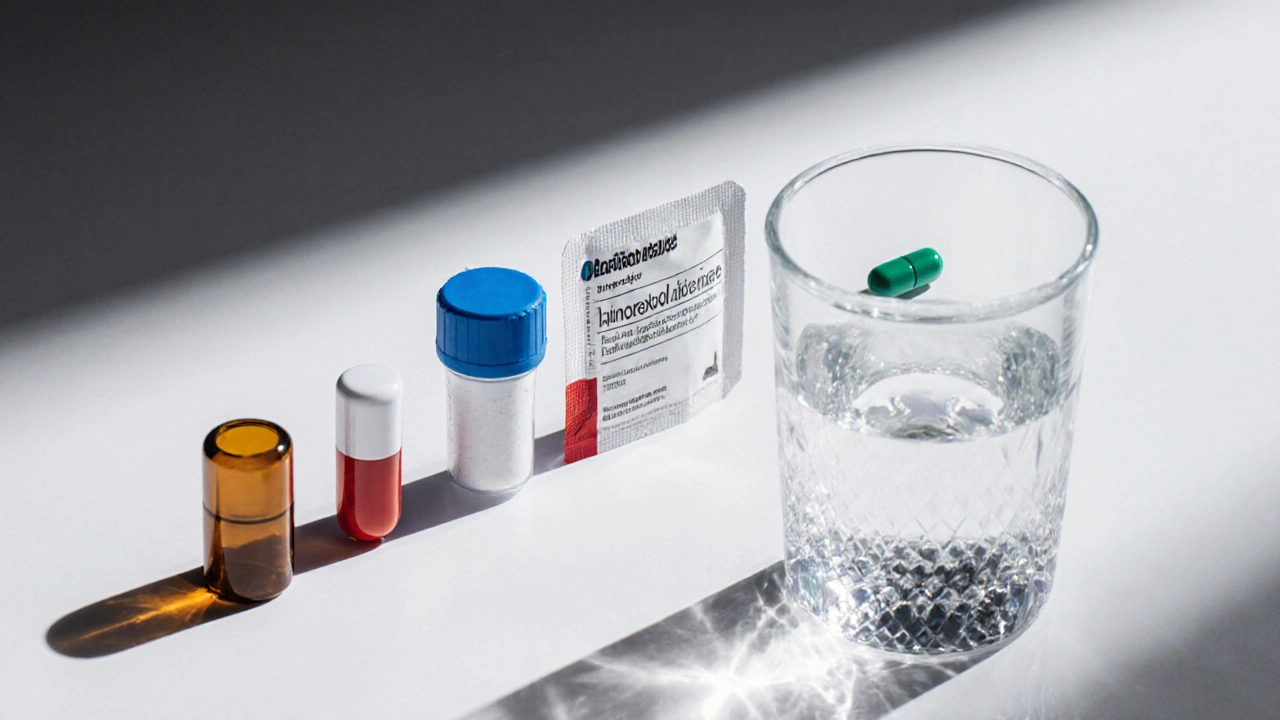Mucolytic Selection Guide
Select Your Condition
Choose the most relevant respiratory condition to get personalized recommendations.
Recommended Mucolytic
Why This Choice?
Key Takeaways
- Bromhexine works by breaking down mucus fibers, offering a rapid onset for productive coughs.
- Ambroxol is a metabolite of bromhexine and provides a longer duration of action.
- Acetylcysteine adds a thiol group to mucus, making it especially useful for chronic bronchitis.
- Guaifenesin is an over‑the‑counter expectorant that thins mucus but has a milder effect.
- Cost, side‑effect profile, and specific respiratory condition determine the best choice.
When treating thick mucus, Bromhexine is a mucolytic drug (bromhexine hydrochloride) that cleaves the glycoprotein bonds in mucus, reducing its viscosity and making it easier to clear from the airways. It’s commonly prescribed for acute bronchitis, COPD exacerbations, and post‑viral coughs. If you’re deciding whether Bromhexine is right for you, consider the factors below alongside the alternatives.
What Is Bromhexine?
Bromhexine (bromhexine hydrochloride) belongs to the class of mucolytic agents. It was first introduced in the 1960s and is approved in over 80 countries. Typical adult dosage is 8mg three times daily, with a peak effect within 30‑60minutes.
Key attributes of bromhexine include:
- Mechanism: Disrupts mucopolysaccharide cross‑links, decreasing sputum thickness.
- Onset: 30‑60minutes.
- Duration: 4‑6hours.
- Common side effects: Nausea, gastrointestinal discomfort, mild rash.
- Regulatory status: Prescription‑only in most regions, OTC in some European countries.
How Bromhexine Works - The Science in Simple Terms
Think of mucus as a tangled web of protein fibers. Bromhexine inserts itself between those fibers, breaking the chemical bridges that hold them together. The result is a looser, more watery sputum that the cilia can move upward more efficiently. This action also stimulates serous glands, increasing the production of thinner fluid that further dilutes the mucus.

Top Alternatives to Consider
Below are the most widely used mucolytics and expectorants that often appear as substitutes for bromhexine.
Ambroxol is the active metabolite of bromhexine. It shares a similar mechanism but adds a local anesthetic effect, soothing irritated airways.
Acetylcysteine (N‑acetylcysteine) supplies a sulfhydryl group that breaks disulfide bonds in mucus, making it especially effective for chronic bronchitis and cystic fibrosis.
Guaifenesin is an over‑the‑counter expectorant that works by increasing hydration of airway secretions; its mucolytic power is milder than prescription agents.
Carbocisteine is a semi‑synthetic mucolytic that reduces mucus viscosity by altering its polymeric structure, commonly used in Europe for COPD maintenance.
Potassium iodide has historical use as a sputum‑thinning agent but is now rarely prescribed due to safety concerns.
Side‑by‑Side Comparison
| Attribute | Bromhexine | Ambroxol | Acetylcysteine | Guaifenesin | Carbocisteine |
|---|---|---|---|---|---|
| Mechanism | Disrupts mucopolysaccharide bonds | Metabolite of bromhexine, adds local anesthetic | Provides sulfhydryl group to break disulfide bonds | Increases airway fluid hydration | Alters polymeric structure of mucus |
| Typical adult dose | 8mg 3×/day | 30mg 3×/day | 200mg 3×/day (oral) or 3‑5mL nebulised | 600‑1200mg every 4‑6h (OTC) | 750mg 3×/day |
| Onset of action | 30‑60min | 45‑90min | 10‑15min (nebulised), 1‑2h (oral) | 1‑2h | 45‑60min |
| Duration | 4‑6h | 6‑8h | 4‑5h (oral), 2‑3h (neb.) | 4‑6h | 5‑7h |
| Common side effects | Nausea, mild GI upset | Metallic taste, mild GI upset | Bad taste, bronchospasm (rare) | Drowsiness, nausea | Headache, GI discomfort |
| Prescription status | Rx in most markets | Rx in most markets | Rx (oral) / OTC (neb.) in some countries | OTC | Rx in many European nations |
| Approx. monthly cost (USD) | $15‑$25 | $20‑$30 | $30‑$45 | $10‑$15 | $25‑$35 |
| Best suited for | Acute bronchitis, post‑viral cough | Chronic cough with airway irritation | Chronic bronchitis, cystic fibrosis | Mild chest congestion, OTC relief | Maintenance therapy for COPD |
Choosing the Right Mucolytic: Decision Guide
Use the following quick rules when deciding between bromhexine and its alternatives:
- Urgent, productive cough? Pick bromhexine or ambroxol for fast relief.
- Chronic mucus overproduction (e.g., COPD, bronchitis)? Consider acetylcysteine or carbocisteine for long‑term thinning.
- Looking for an OTC option? Guaifenesin offers modest effect without a prescription.
- Concern about side effects? Ambroxol tends to cause fewer GI complaints, while acetylcysteine may provoke bronchospasm in sensitive patients.
- Budget matters? Guaifenesin is the cheapest, but prescription agents generally provide stronger clinical outcomes.
Safety Profile and Drug Interactions
All mucolytics share a relatively safe profile, yet some nuances matter.
Bromhexine can mildly increase gastric acidity, so concurrent use with non‑steroidal anti‑inflammatory drugs (NSAIDs) may raise ulcer risk. Ambroxol’s local anesthetic effect can interact with other cough suppressants, potentially causing excessive sedation if combined with opioids.
Acetylcysteine is a known antioxidant; it may enhance the efficacy of certain bronchodilators but also increases the risk of bronchospasm when nebulised in patients with severe asthma. Guaifenesin has few interactions but may amplify central nervous system depressants like diphenhydramine.
Pregnancy and lactation considerations: bromhexine and ambroxol are generally regarded as low risk (Category B in many jurisdictions), whereas acetylcysteine is Category C, and guaifenesin is Category C‑D in the U.S.

Cost, Availability, and Insurance Coverage
Pricing varies by country and insurance plan. In the United States, many insurers cover prescription mucolytics when a physician documents a chronic lung disease indication. OTC guaifenesin is widely available in pharmacies and supermarkets, making it the most accessible choice for occasional chest congestion.
Internationally, bromhexine is often sold over the counter in Greece, Turkey, and parts of Eastern Europe, while ambroxol is OTC in many Asian markets. Acetylcysteine requires a prescription for oral tablets in the U.S. but is OTC for nebulised solutions in Canada.
Practical Tips for Use
- Take mucolytics with a full glass of water to aid dissolution.
- Avoid taking them right before bedtime unless you’re certain the cough won’t disturb sleep.
- Combine with adequate hydration and gentle chest physiotherapy for best clearance.
- If you experience worsening wheezing after a dose of acetylcysteine, seek medical advice immediately.
- Do not double‑dose; most side effects are dose‑related.
Frequently Asked Questions
What makes bromhexine different from ambroxol?
What makes bromhexine different from ambroxol?
Bromhexine is the parent compound; ambroxol is its active metabolite. Both break down mucus, but ambroxol also numbs irritated airway surfaces, which can reduce cough reflex intensity.
Can I use bromhexine with a bronchodilator?
Yes, they work via different pathways. Combining a mucolytic like bromhexine with a bronchodilator (e.g., albuterol) often improves overall airway clearance.
Is acetylcysteine better for chronic bronchitis?
For long‑term mucus management in chronic bronchitis, acetylcysteine (especially nebulised) is frequently preferred because its sulfhydryl groups effectively disrupt thick secretions over repeated use.
Can I take guaifenesin if I’m already on bromhexine?
Generally safe, but the combined effect may be redundant. If symptoms are severe, a single stronger prescription mucolytic (like bromhexine or ambroxol) is usually sufficient.
What should I do if I miss a dose?
Take the missed dose as soon as you remember, unless it’s within 4hours of the next scheduled dose. In that case, skip the missed one and continue the regular schedule.
Next Steps
Talk to your healthcare provider about the specific cough pattern you’re dealing with. Ask whether a short‑term prescription bromhexine or a longer‑term agent like acetylcysteine fits your health history. Keep a symptom diary for a week-note sputum color, thickness, and how often you cough. That record helps the clinician tailor the right mucolytic and avoid unnecessary medication.



Comments
While the article is thorough, I couldn't help noticing a few basic slip‑ups that could have been avoided. For example, the bullet points sometimes miss a period at the end, and the use of “etc.” feels redundant after the exhaustive list. Also, there is an inconsistent mix of British and American spelling that distracts the reader. A quick proofread would polish what is otherwise solid content.
One might argue that the occasional typographical blemish mirrors the imperfect nature of the human lungs we seek to heal; the body, after all, is rarely pristine, and perhaps the text nudges us toward humility. In the grand tapestry of mucolytic science, the stray commas serve as tiny reminders that even our best‑crafted formulas have room for refinement. Yet the underlying knowledge shines through, transcending the superficial flaws.
Choosing the right mucolytic can feel like navigating a labyrinth of biochemical whispers!!! Each agent-Bromhexine, Ambroxol, Acetylcysteine, Guaifenesin, Carbocisteine-holds a unique key to the mucus kingdom 🚀. First, consider the speed of onset; Bromhexine strikes within half an hour, a true sprint compared to the leisurely stroll of Guaifenesin. Second, weigh the duration; a 4‑6 hour window for Bromhexine ensures sustained relief without constant dosing. Third, side‑effects matter; the gentle nausea of Bromhexine is often tolerable, whereas Acetylcysteine’s bitter taste can be daunting. Fourth, think about accessibility; OTC options like Guaifenesin democratize care, while prescription‑only drugs may be barred by insurance hurdles. Fifth, factor in the underlying condition; chronic bronchitis may benefit from the sulfhydryl power of Acetylcysteine, but an acute post‑viral cough often resolves faster with Bromhexine’s rapid action. Sixth, never underestimate the power of proper hydration; even the most potent mucolytic falters without sufficient fluid intake. Seventh, chest physiotherapy synergizes with any mucolytic, turning chemical thinning into mechanical clearance. Eighth, remember drug interactions; Bromhexine can increase gastric acidity, so pairing with NSAIDs requires caution. Ninth, the cost equation cannot be ignored; a $20 monthly spend may be justified for severe COPD exacerbations but feels extravagant for occasional congestion. Tenth, patient preference for taste and administration route influences adherence-some lovers of liquid nebulisation will shy away from tablets. Eleventh, regulatory landscapes differ; what is OTC in Europe may be Rx in the United States, shaping real‑world choices. Twelfth, the psychological comfort of knowing a medication works can itself improve breathing outcomes; placebo effects are real. Thirteenth, always consult a healthcare professional to tailor therapy-generic advice rarely fits every airway. Fourteenth, keep a symptom diary; noting sputum volume, color, and cough frequency guides future adjustments. Fifteenth, stay updated-new formulations and combination therapies emerge regularly, promising even better mucus management. Finally, embrace the journey of trial, error, and eventual mastery over your respiratory health 😊.
Ah, a comprehensive dissertation on mucus that could double as a bedtime story-how thrilling! Your enthusiasm for enumerating every conceivable factor is genuinely admirable, if slightly exhausting. I suppose we now all know that the optimal mucolytic regimen requires a Ph.D. in pharmacology, a hydration schedule, and a personal diary. Rest assured, the medical community will forever be in your debt for this epic saga.
In a methodical appraisal of the preceding exposition, it becomes evident that while rhetorical flourish is abundant, empirical rigor remains marginal. The author enumerates variables without furnishing statistical substantiation, thereby impeding reproducibility. Moreover, the invocation of patient adherence as a variable is trivial without quantifiable adherence metrics. Consequently, the treatise, albeit verbose, lacks the analytical depth requisite for clinical decision‑making.
Hey, great points! Even though the write‑up could use more data, you nailed the big picture-knowing your options is half the battle. If you ever need a quick cheat‑sheet or just someone to bounce ideas off, I'm happy to help. Keep the conversation going, and don’t let the jargon scare you away from finding the right sputum‑buster for you!
From an ethical standpoint, clinicians bear a solemn responsibility when selecting mucolytic agents for patients. Prescribing a potent drug like Bromhexine without thorough assessment may expose vulnerable individuals to unnecessary side effects, contravening the principle of non‑maleficence. Conversely, withholding effective therapy due to cost concerns could violate beneficence, especially for those suffering chronic bronchial obstruction. Therefore, a balanced, patient‑centered approach that weighs clinical efficacy against potential harm and financial burden is paramount.
It is no coincidence that the pharmaceutical narrative around mucolytics suddenly emphasizes cost‑effectiveness over transparency. Historically, drug manufacturers have engineered regulatory loopholes to keep cheaper generics out of the market, ensuring continued profit. The push for “patient‑centered” decision‑making often masks covert lobbying that steers physicians toward brand‑name prescriptions. One must remain vigilant against such orchestrated campaigns that subtly dictate our therapeutic choices.
Indeed, the clandestine machinations of the pharmaceutical consortium merit a meticulous exegesis, for within their stratagem lies a labyrinthine tapestry of influence that permeates both clinical guideline formulation and prescriber behavior. When dissecting the interstitial corridors of this covert operation, one discerns that the ostensibly benign emphasis on pharmacoeconomics serves as a veneer for an ulterior motive: the consolidation of market dominance through the suppression of alternative, perhaps more efficacious, mucolytic agents. Such a paradigm, cloaked in the rhetoric of patient welfare, inexorably culminates in the erosion of true clinical autonomy, thereby relegating the practitioner to a mere conduit for corporate intent. It is incumbent upon the discerning scholar to illuminate these obscured pathways, lest the silent perpetuation of this hegemony persist unabated, to the detriment of both individual patient outcomes and the broader epistemic integrity of respiratory therapeutics.
Ah, the grand tableau of hidden agendas-truly a drama worthy of Shakespeare, but with a dash of modern corporate intrigue. While we revel in dissecting conspiracies, let's not forget that cultural perceptions of health differ vastly across continents; in some societies, the very notion of questioning a prescription is tantamount to sacrilege. Yet, as a self‑appointed cultural liaison, I must point out that the global pharmaco‑politics tapestry is stitched not only with covert contracts but also with genuine attempts to harmonize treatment standards. So, while the melodrama of secret cabals swirls, we can also celebrate the earnest collaborations that bring life‑saving mucolytics to remote clinics. In short, the world is simultaneously a stage for both intrigue and altruism-perhaps a paradox we should embrace with a wink and a sigh.
Honestly, this thread could use a break.